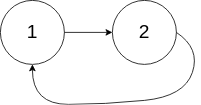LeetCode-in-All
142. Linked List Cycle II
Medium
Given the head of a linked list, return the node where the cycle begins. If there is no cycle, return null.
There is a cycle in a linked list if there is some node in the list that can be reached again by continuously following the next pointer. Internally, pos is used to denote the index of the node that tail’s next pointer is connected to (0-indexed). It is -1 if there is no cycle. Note that pos is not passed as a parameter.
Do not modify the linked list.
Example 1:

Input: head = [3,2,0,-4], pos = 1
Output: tail connects to node index 1
Explanation: There is a cycle in the linked list, where tail connects to the second node.
Example 2:

Input: head = [1,2], pos = 0
Output: tail connects to node index 0
Explanation: There is a cycle in the linked list, where tail connects to the first node.
Example 3:

Input: head = [1], pos = -1
Output: no cycle
Explanation: There is no cycle in the linked list.
Constraints:
- The number of the nodes in the list is in the range
[0, 104]. -105 <= Node.val <= 105posis-1or a valid index in the linked-list.
Follow up: Can you solve it using O(1) (i.e. constant) memory?
To solve the “Linked List Cycle II” problem, we need to find the node where the cycle begins in a linked list, if there is a cycle. We’ll use Floyd’s Tortoise and Hare algorithm to detect the cycle and then determine the starting node of the cycle.
Steps to Solve the Problem
- Cycle Detection:
- Use two pointers,
slowandfast, to detect if a cycle exists. Both pointers start at the head of the linked list. - Move
slowone step at a time andfasttwo steps at a time. - If
slowandfastmeet, a cycle exists.
- Use two pointers,
- Finding the Start of the Cycle:
- If a cycle is detected, initialize another pointer,
start, at the head of the list. - Move both
startandslowone step at a time. - The point where they meet is the start of the cycle.
- If a cycle is detected, initialize another pointer,
- Return Result:
- If no cycle is detected, return
nil. - If a cycle is detected, return the node where
startandslowmeet.
- If no cycle is detected, return
Swift Implementation
Here’s the Swift implementation of the Solution class:
// Definition for singly-linked list.
class ListNode {
var val: Int
var next: ListNode?
init(_ val: Int) {
self.val = val
self.next = nil
}
}
class Solution {
func detectCycle(_ head: ListNode?) -> ListNode? {
guard head != nil else { return nil }
var slow = head
var fast = head
// Cycle detection
while fast != nil && fast?.next != nil {
slow = slow?.next
fast = fast?.next?.next
if slow === fast {
// Cycle detected, now find the start of the cycle
var start = head
while start !== slow {
start = start?.next
slow = slow?.next
}
return start
}
}
// No cycle detected
return nil
}
}
Explanation of the Swift Code
- Initialization:
- The
ListNodeclass defines the structure of a node in the linked list. - The
Solutionclass contains thedetectCyclemethod which finds the start of the cycle if it exists.
- The
- Cycle Detection:
- Initialize
slowandfastpointers to the head of the linked list. - Use a
whileloop to moveslowone step andfasttwo steps at a time. - If
slowandfastmeet, a cycle is detected.
- Initialize
- Finding the Start of the Cycle:
- If a cycle is detected, initialize
startat the head of the list. - Move both
startandslowone step at a time until they meet. - The meeting point is the start of the cycle.
- If a cycle is detected, initialize
- Return Result:
- If no cycle is detected, the function returns
nil. - If a cycle is detected, the function returns the node where
startandslowmeet.
- If no cycle is detected, the function returns
This approach ensures that we detect the cycle efficiently and find the starting node of the cycle using constant space (O(1) memory), adhering to the problem constraints.

